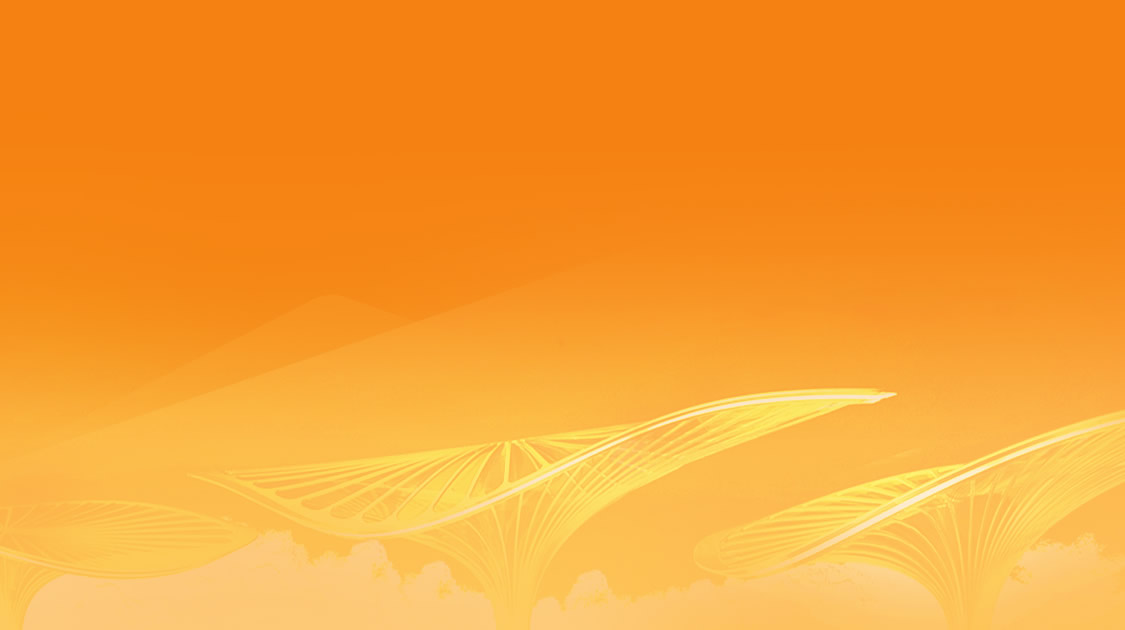什么是“幸福之城”? 成都给出了一个定义: 或许是一次推窗见雪山的震撼,或许是一次绿道骑行的潇洒,或许是一次博物馆之旅的奇 妙,又或许是一次热辣火锅后的酣畅淋漓……
What is a City of Happiness? According to the definition by people living in Chengdu, it may be an impressive glimpse of the snow mountains in and around the city, a joyful bike tour along the Tianfu Greenway, a wonderful visit to a museum in the city, or a delicious bite of authentic Sichuan hotpot…
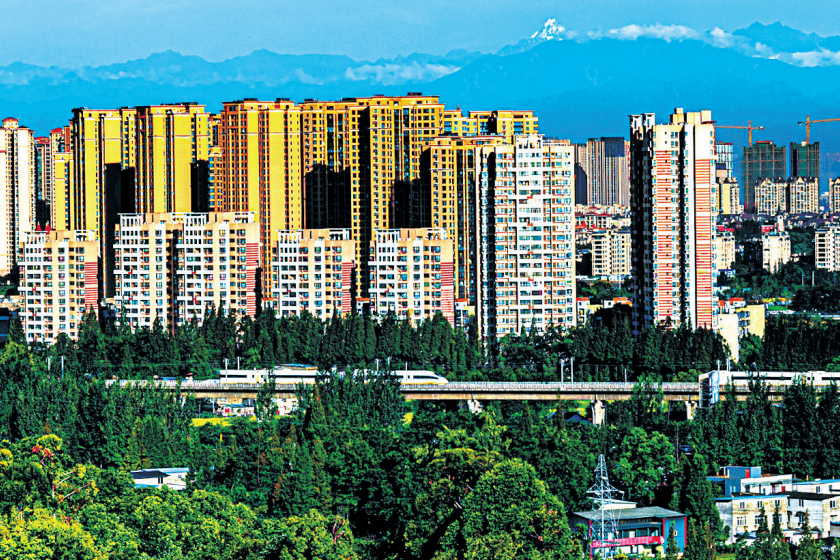
去年底,成都再次登上“中国最具幸福感城市”榜首, 并创下十四连冠的荣耀记录。 At the end of 2022, Chengdu once again topped the rankings of the Happiest Cities in China. It is the 14th consecutive year that the city has won the title.
成都人的幸福感,自古有之,多姿多彩。有诗为证—— “九天开出一成都,万户千门入画图。”万家灯火, 是李白眼里的幸福;“成都海棠十万株,繁华盛丽天下无。” 繁盛无双,是陆游眼里的幸福;“晓看红湿处,花重锦 官城。”惊喜惬意,是杜甫眼里的幸福。 Chengdu people’s sense of happiness has been rooted in their genes since the ancient times. Many famous poems testify to that. “A paradise on earth, Chengdu is dynamic and thriving with people living here happily.” In the eyes of romantic poet Li Bai (701-762), happiness is the city lights at Chengdu, a Time-honored City of Happiness 80 81 世园第六期大16开.indd 80-81 2023/3/20 14:55night. “When one hundred thousand Chinese flowering crab apple trees are in full bloom in Chengdu, the beautiful scene is unparalleled under heaven.” In the eyes of famous poet Lu You (1125-1210), happiness is the prosperity and growth of the city. “Dawn sees saturated reds, and the town’s heavy with blooms.” In the eyes of realistic poet Du Fu (712-770), happiness is a little surprise in life and peace of mind.
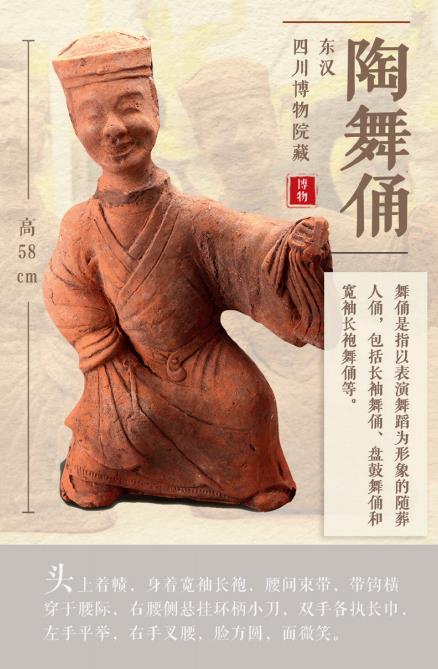
幸福的人总是面带笑容。《说文解字》里,对“笑”字进行了解读。从造 字来说,“夭”,既是声旁也是形旁,表示扭动身体, 挥臂起舞。笑的造字本义,也就是手舞足蹈并发出兴奋、快乐的声音。 Happy people always wear a pleasant smile on their faces. According to the Shuowen Jiezi (Explaining Simple and Analyzing Compound Characters, the first Chinese dictionary to analyze the structure of Chinese characters and to give the rationale behind them, as well as the first to use the principle of organization by sections with shared components, called radicals), the character 笑 (smile or laugh) looks like a person who is waving his (her) arms and dancing merrily while making a joyful sound.
成都人的爱笑刻入基因,温柔的笑、灿烂的笑、迷之微笑;会心的笑、得意洋洋的笑、心有灵犀的笑; 洒脱的笑、窃喜的笑、傲娇的笑…… Having a bright and cheerful disposition, Chengdu people are open-minded and optimistic. Sometimes, they smile tenderly. Sometimes, they laugh brightly. Sometimes, they smile heartily. Sometimes they grin with delight. Sometimes, they chuckle to themselves. And, sometimes, they smile proudly…
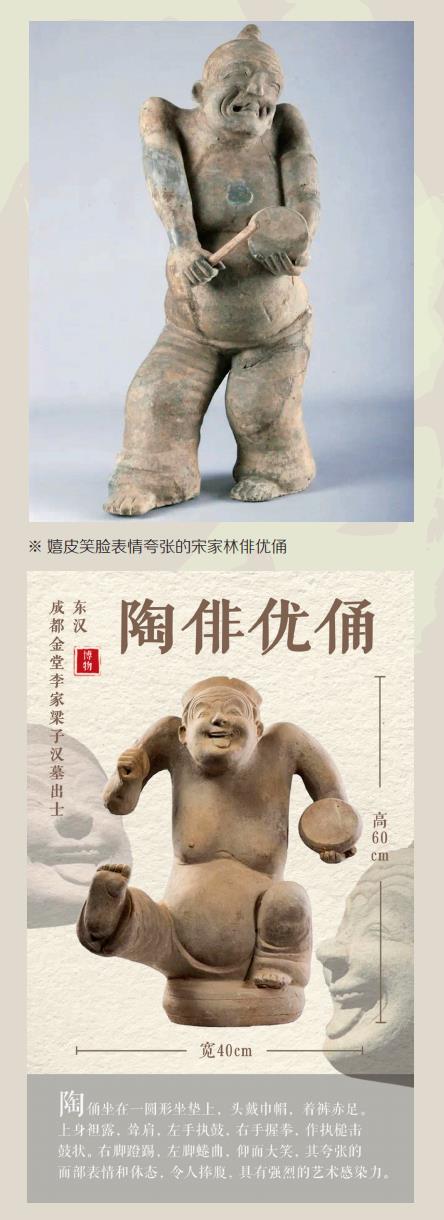
蜀人走过千年岁月,带着一抹微笑,清风拂山岗, 明月照大江。
They are easygoing, inclusive, generous and positive in the face of any difficulties and challenges.

他们笑创石室兴教,蜀学生辉;笑叹蜀道难行, 天堑飞渡;笑享歌舞宴乐,既丽且崇;笑开丝路通达,万商成渊;笑迎四方来客,海纳百川…… Some 2000 years ago, the first official school in China was established in Chengdu. “It is easier to climb to heaven than take the Sichuan road.” But the people here have made the rough roads plain, and made their city prosperous culturally and economically.
成都人的乐观主义与生俱来,有物为证—— 近几十年来,成都及周边地区陆续出土了许多东 汉陶俳优俑,又名说唱俑、击鼓说唱俑,它们都带着 各式各样的笑容:憨笑、嬉笑、搞怪坏笑、开怀大笑…… 生动的造型、传神的表情,让人不由感慨:成都 人爱笑,原来是祖传的!
Chengdu people are born with instinctual optimism and intrinsic motivation. Over the past decades, a great number of vivid and peculiarlyshaped pottery figurines have been unearthed from the Eastern Han Dynasty (25-220) tombs in and around the city. With various facial expressions and smiles, the lifelike figurines with exquisite craftsmanship show Chengdu people are genetically optimistic and are born to laugh.
“笑”,是手之舞之足之蹈之。
Smile is a great joy from the bottom of people’s hearts.
1954 年,成都羊子山陶俳优俑破土而出。俑身为红陶质,俑高 53 厘米。
In 1954, a red 53-centimer-tall pottery comedian figurine was unearthed from Yangzishan, Chengdu.
俳优坐于一圆榻之上,头戴平顶小帽,帽前束花结,两肩高高耸起。上身袒露,下身穿一条浅裆长裤,赤着双足,一足前蹲,一足跪屈。左手抱一圆鼓置于 膝上,右手臂屈伸作握槌状,食指向上斜指。圆圆的 胖脸眉开眼笑,额头因此堆出了几道深深的皱纹。
Sitting on a round cushion,the male comedian wears a flat hat with a knot in its front. His shoulders are hunched up. Naked from the waist up, he wears a pair of drop-crotch trousers and is barefoot, with one foot crouching forward and the other kneeling. He holds a round drum in his left hand, and his right arm flexes with the index finger slanting upwards as if to hold a mallet. With a broad smile on his round fat face, his forehead etches with deep lines.
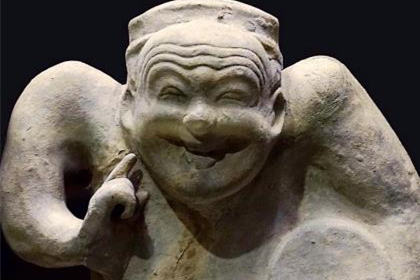
出土于 1963 年的郫都区宋家林俳优俑,灰陶质, 俑高 66.5 厘米,身材矮胖,椎髻。
exaggerated facial expression. He is naked from the waist up, exposing his chest and belly. His neck is stretched forward and his shoulders are hunched up. He narrows his eyes, sticks out his tongue, and hangs his huge head down on his chest like a marionette. Holding a drum in one of his hands and a mallet in the other, he is about to beat the drum.
俑龇牙咧嘴、嬉皮笑脸,面部表情十分夸张。上身赤裸,袒露胸腹。脖子前伸,双肩耸起。双眼眯成 了一条缝,舌头伸得老长,硕大的脑袋木偶般挂在胸 前。一手捧鼓,一手持槌,正欲击鼓。
He bares his teeth and grins, with an muscles and a bulging belly. He wears a beaded ring on his left arm, holding a drum under the arm and a mallet horizontally in his right hand. He is barefoot, wears long pants and sits on a round cushion, putting his right foot up and showing his thick sole of the foot.
同一地区出土的,还有一件女性陶持扇俑。 发髻戴花,坐相端正,在她清秀的面庞上,笑意 相对“含蓄”。
A pottery female figurine holding a fan was unearthed in the same area. She sits upright with flowers in her bun. There is a faint smile on her pretty face.
1957 年,成都天回山陶俳优俑出土。俑高 56 厘米,俑头束巾,戴笄。俑为圆脸,满面笑容, 前额上有数道深深的皱纹。上身赤裸,胸肌下垂, 肚大如鼓。两臂戴有珠状环形饰物,左手抱鼓于 腋下,右手持槌平举。下身着大脚长裤,赤足坐 于圆榻之上,右足高高跷起,露出肥厚的脚掌。
In 1957, a 56-centimeter tall pottery comedian figurine was unearthed in Tianhui Mountain, Chengdu. He wears a turban and a hairpin. With a broad smile on his round face and deep wrinkles on his forehead, he is bare-chested with sagging pectoral The figurine was excavated in Songjialin, Pidu District in 1963. Made of gray pottery, it is 66.5 centimeters tall with a squat body and a tapered bun on the head.

新都马家山陶俳优俑,俑高 48 厘米,与成都天 回山陶俳优俑造型较为接近。俑头上束巾,戴笄。张 口露舌、圆脸上的笑容极为夸张。上身赤裸,袒胸露腹。 双臂戴有类似璎珞的环形佩饰,左手环抱一鼓,右手握槌向前平伸(鼓槌似已失落)作击鼓状。下身穿宽松长裤,赤足。右足向前伸出,左足支立于圆榻上。
The pottery comedian figurine unearthed in Majiashan, Xindu, is 48 centimeters tall, similar to that excavated in Tianhui Mountain. He wears a turban and a hairpin. With an exaggerated smile on his round face, he opens his mouth wide. Bare-chested, he wears floral adornments on his arms. He holds a drum in his left hand and a mallet in his right hand, as if beating a drum. He wears slacks and is barefoot, stretching his right foot forward and putting his left foot on the cushion.
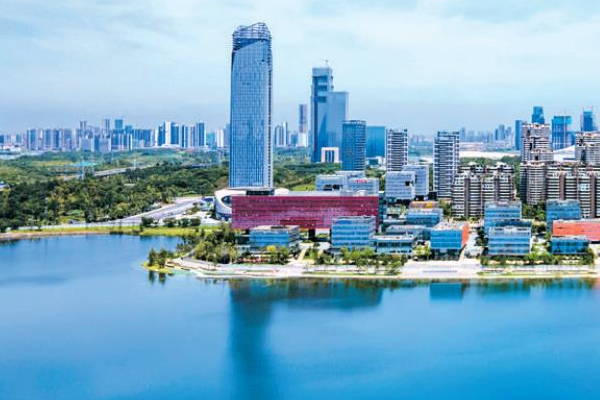
金堂李家梁子俳优俑为泥质灰陶,高60厘米,宽40 厘米,较很多站式俑还要高出一截,是目前出 土最大的坐式陶俳优俑之一。此俑头戴小圆帽,满面 印象笑容,舌头长伸。上身裸露,耸肩。右手托鼓,左手作 握槌状。肚腹浑圆,下身着浅裆长裤,赤足坐于圆榻上。 左足支于肚前,右足向前蹬出。
The clay gray pottery figurine unearthed from Lijialiangzi, Jintang, is 60 centimeters tall and 40 centimeters wide, much taller than many standing figurines excavated so far. It is one of the largest sitting pottery figurines ever unearthed. He wears a small round hat, with a broad smile on his face and his tongue sticking out. He is bare-chested and his shoulders are hunched up. Holding a drum in his right hand and a mallet in his left hand, he has a beer belly, wears a pair of drop-crotch trousers, sitting barefoot on a round cushion. Propping his left foot in front of his belly, he stretches out his right foot.

成都六一一所汉墓,也是东汉陶俑的聚集之地。 这件“陶吹箫俑”就是代表之一。
The Han Dynasty Tomb located at Chengdu 611 Research Institute is home to a large number of pottery figurines. The flute-playing pottery figurine is one of the excavations from the tomb.
这里不仅有常见的俳优俑,还有自带案板的“庖 厨俑”。案板上有鸡鸭鱼肉,还有鲜菜美酒,从“厨师 们”脸上的微笑中,仿佛能够感受到那份对美食美味的 追求,与对美好生活的热爱。
In the tomb, pottery figurines of cooks and chopping boards were unearthed. On the boards, there are all kinds of meat and vegetables. From
the smiles on their faces, we can feel their pursuit of delicious food and love for a better life.
2000 年前的古蜀大地,街道上车水马龙、人流 如梭,街道的两边,商铺、酒肆、茶楼鳞次栉比,丝 竹之声不绝于耳。
2,000 years ago, in the ancient Kingdom of Shu, the hustling and bustling streets of Chengdu were lined with shops, restaurants and tea houses, and was filled with beautiful music.
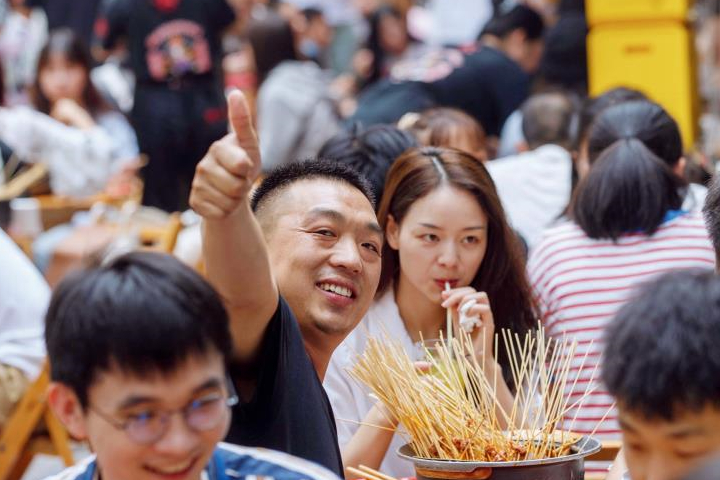
2000 年后的天府之国,“雪山下的公园城市、 烟火里的幸福成都”闻名于世,这里的人们言笑晏晏, 安居乐业。幸福感,已经融入成都人的骨血;笑容,已经被刻进成都人的 DNA。拥有“祖传微笑”的成都人,今天,你们感到幸福了吗?
After 2000 years, here in Chengdu, a park city at the foot of snow mountains, people live and work in peace and contentment, creating and looking forward to a better life. Chengdu, one of the happiest cities in China, can make you happier and your dreams come true

